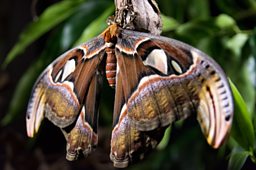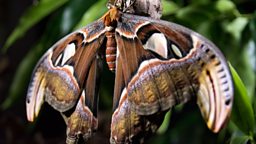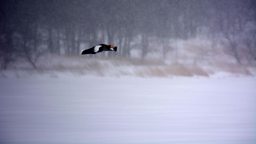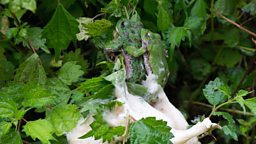Atlas moths
Ester de Roij: Researcher
When I was living in Japan I travelled around as much as I could. The places I never managed to visit I could probably count on one hand, and I was pretty much prepared for anything in this series. But I never thought this would take me to Yonaguni, 80km off the Taiwanese coast. I was off to the tropics, packing shorts and a head torch for some night-time filming.
Scrambling and fumbling to get the lighting right, we had our first shot in the bag. Now to get everything else, and in not very much time indeed!
Before flying we had had extensive talks with the airlines, warning them about all our kit as they wouldn’t have allowed us to fly otherwise due to the size of the planes. We flew down to Naha, and then boarded a little 25-seater plane to fly us all the way down south. We were collected by Hachiro Aratake, the man behind the Yonaguni monument, and owner of the hotel we had arranged to stay in. A stout islander whose personal history is entwined in that of the island.
After settling in, we met up with Mr. Matsumoto - our contact at the local museum about atlas moths, and his love for their well-being has saved these wonderful creatures in the past. He showed us some cocoons that were nearly ready to hatch, and Mark Payne-Gill, our cameraman who had a deep love for atlas moths in common with Mr. Matsumoto set up his camera to try and film the moths emerging. They were still wriggling around like crazy, which in Mark’s experience isn’t a sign of their hatching anytime soon. But we waited, and waited, and waited some more.
On shifts watching the cocoons (we had about 3 that were equally mature) non-stop. We only had 8 days to film the entire sequence, and we hadn’t even got to flying so naturally, we started getting very nervous. Until, without warning and with the same amount of wriggling as before, one ate its way out of the top of the cocoon. Scrambling and fumbling to get the lighting right, we had our first shot in the bag. Now to get everything else, and in not very much time indeed!
We now had two females hatched in our spot (the third was still in no hurry to leave the safety of its cocoon), and next on our list was flight shots. Once the females were wafting their pheromones to attract wild males, it was once again a waiting game (though this time we could adjust our sleeping schedules to film from 9pm till 6am and somehow get some rest during daylight hours). We heard a crash, something falling to the floor, and then something whizzing past our heads. A male atlas moth. Though something wasn’t quite right about the way it was flying. It kept on bumping into things, and although it looked like it was flying towards the female, it looked lost and panicked.
Moths are nighttime creatures and they could not fly straight with our lights on
And then it hit us (not literally) – the light. Moths are nighttime creatures and they could not fly straight with our lights on. We had brought some infrared equipment to test, and what a better way to test it then as a last-ditch effort to film something in flight? The infrared light had an immediate effect, and although it took us another few days to get it right – even our infrared light was ever so slightly disorientating.
It was time to leave the little island of 2000-odd inhabitants behind and board the little plane again. It felt strange, somehow, to be leaving the serenity of island life behind for the buzzing, bustling Tokyo.







